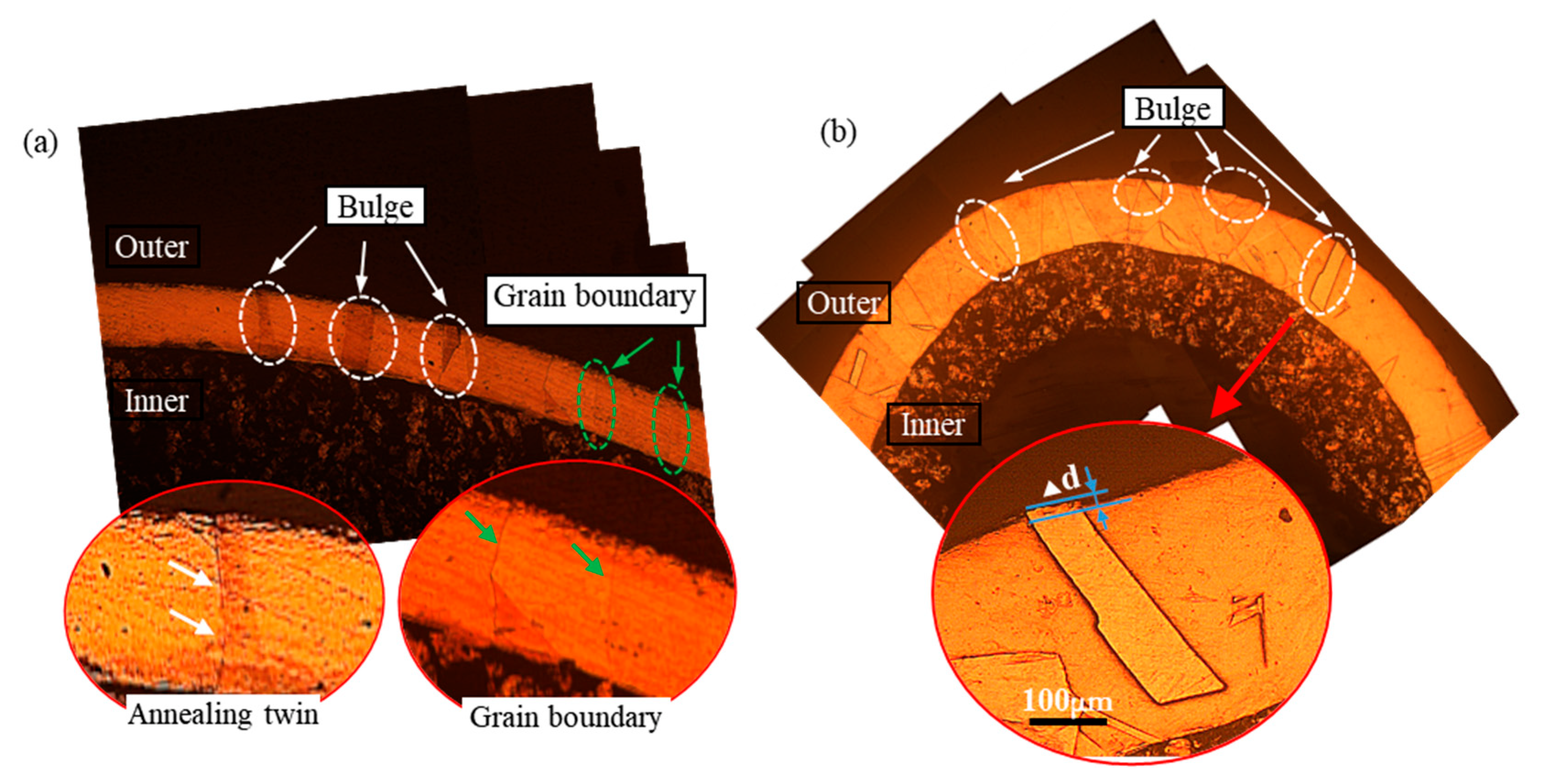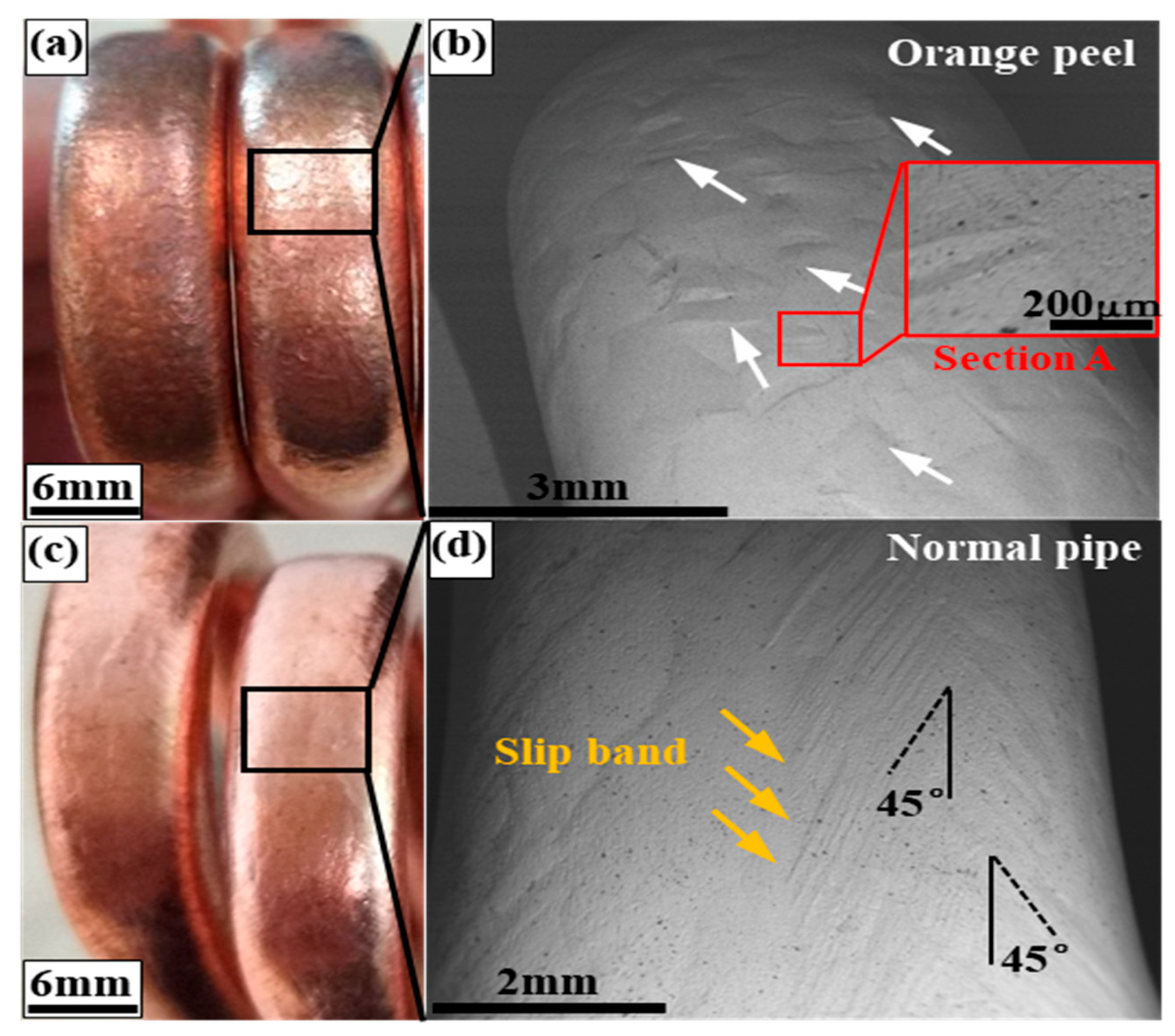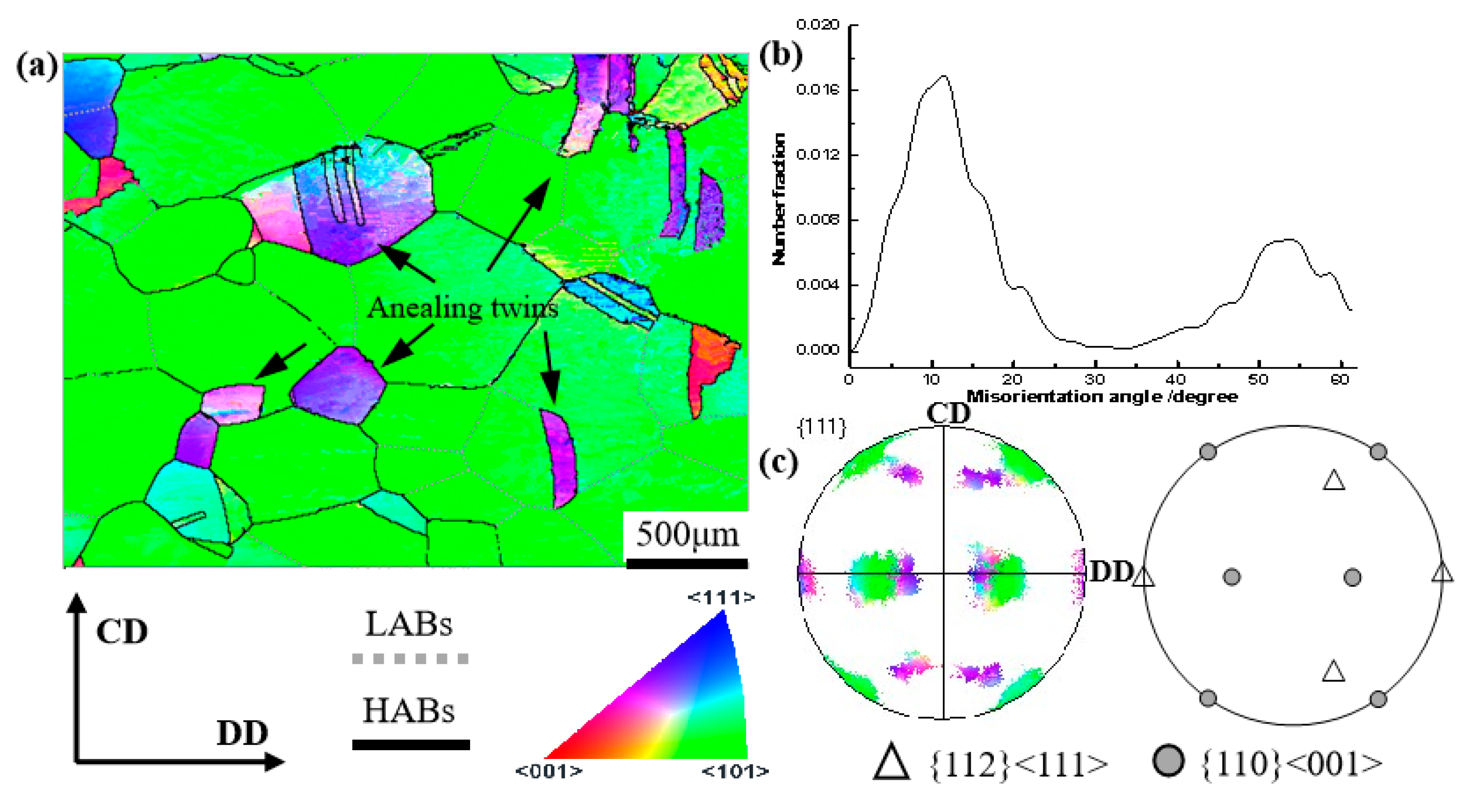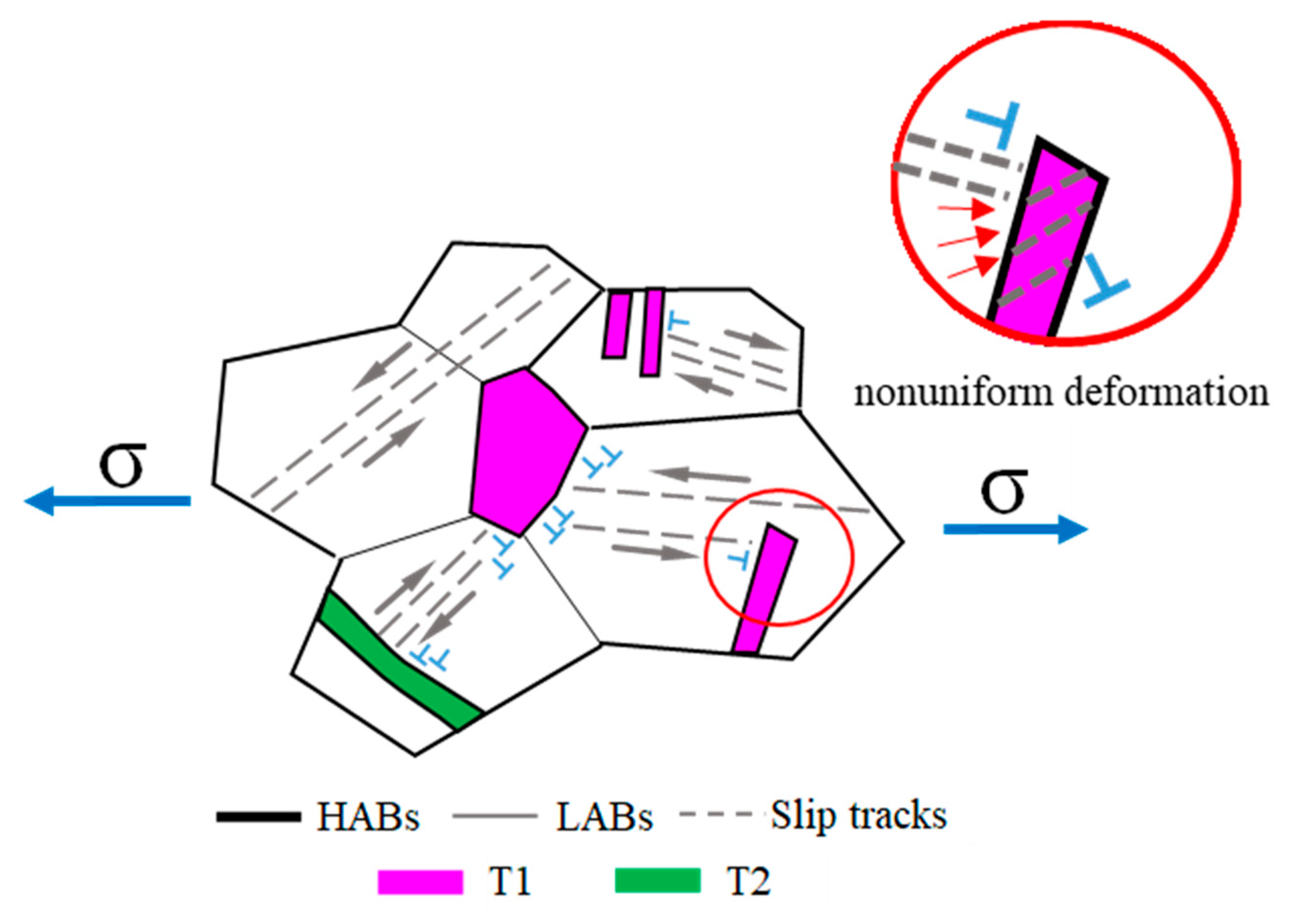Special-Oriented Annealing-Twins-Induced Orange Peel Morphology of Heat Pipe under Bending Deformation
Abstract
:1. Introduction
2. Materials and Methods
3. Results and Discussion
3.1. Microstructure of the Heat Pipe after Bending Deformation
3.2. Characterization of Orange Peel Morphology on the Bent Surface
3.3. Deformation Inhomogeneity between Annealing Twins and Matrix Grains
4. Conclusions
- (1)
- The orange peel defect of heat pipes is caused by inhomogeneous intergranular deformation between the annealing twins and matrix grains, which exhibit nonuniform size and crystal orientation. The annealing twins exhibit a hard orientation in bending deformation and may bulge out on the pipe surface, which presents an uneven morphology.
- (2)
- The matrix grains seriously coarsen and form a strong {110} <001> Goss texture during high-temperature sintering treatment, while the annealing twins in it show a {112} <111> copper texture. Thus, the annealing twins act as a barrier for the slip of dislocations by both the unique orientation with the matrix grains and the twin-type boundaries.
- (3)
- According to the above results, it is suggested that orange peel defects on bending surfaces of heat pipes can be relieved by reducing or eliminating the proportion of “hard-oriented” annealing twins or by inhibiting recrystallized grains’ growth, such as by adding alloying elements.
Author Contributions
Funding
Institutional Review Board Statement
Informed Consent Statement
Data Availability Statement
Acknowledgments
Conflicts of Interest
References
- Vasiliev, L.L. Heat pipes in modern heat exchangers. Appl. Therm. Eng. 2005, 25, 1–19. [Google Scholar] [CrossRef]
- Nie, N.; Su, L.H.; Deng, G.Y.; Li, H.J.; Yu, H.L.; Tieu, A.K. A review on plastic deformation induced surface/interface roughening of sheet metallic materials. J. Mater. Res. Tec. 2021, 15, 6574–6607. [Google Scholar] [CrossRef]
- Miranda, M.L.; Somkuti, P.; Bianchi, D.; Cihak-Bayr, U.; Bader, D.; Jech, M.; Vernes, A. Characterization of orange peel on highly polished steel surfaces. Surf. Eng. 2015, 31, 519–525. [Google Scholar] [CrossRef]
- Romanova, V.; Balokhonov, R.; Panin, A.; Kazachenok, M.; Kozelskaya, A. Micro-and mesomechanical aspects of deformation-induced surface roughening in polycrystalline titanium. Mater. Sci. Eng. A 2017, 697, 248–258. [Google Scholar] [CrossRef]
- Sunal, A.P.; Yasin, K.K.; Onur, K. On the utilization of Sachs model in modeling deformation of surface grains for micro/meso scale deformation processes. J. Manuf. Process 2021, 68, 1086–1099. [Google Scholar]
- Grzegorz, S.; Ryszard, B.; Bartlomiej, Z. Deformation-induced roughening by contact compression in the presence of oils with diferent viscosity: Experiment and numerical simulation. Tribol. Lett. 2020, 68, 117. [Google Scholar]
- Cai, Y.; Wang, X.S.; Du, Y. Surface roughening behavior of the 6063-T4 aluminum alloy during quasi-in situ uniaxial stretching. Materials 2022, 15, 6265. [Google Scholar] [CrossRef] [PubMed]
- Liewald, M.; Hönle, S.; Sindel, M. Surface roughening of an aluminum 6016 alloy during bending and hemming. Int. J. Mater. Form. 2015, 9, 203–213. [Google Scholar] [CrossRef]
- Cai, Y.; Wang, X.S.; Yuan, S.J. Analysis of surface roughening behavior of 6063 aluminum alloy by tensile testing of a trapezoidal uniaxial specimen. Mater. Sci. Eng. A 2016, 672, 184–193. [Google Scholar] [CrossRef]
- Guilhem, Y.; Basseville, S.; Curtit, F.; Stéphan, J.M.; Cailletaud, G. Numerical investigations of the free surface effect in three-dimensional polycrystalline aggregates. Comput. Mater. Sci. 2013, 70, 150–162. [Google Scholar] [CrossRef] [Green Version]
- Rossiter, J.; Brahme, A.; Inal, K.; Mishra, R. Numerical analyses of surface roughness during bending of FCC single crystals and polycrystals. Int. J. Plast. 2013, 46, 82–93. [Google Scholar] [CrossRef]
- Kishimoto, T.; Sakaguchi, H.; Suematsu, S.; Tashima, K.; Kajino, S.; Gondo, S.; Shinsuke, S. Deformation behavior causing excessive thinning of outer diameter of micro metal tubes in hollow sinking. Metals 2020, 10, 1315. [Google Scholar] [CrossRef]
- Shi, Y.; Wu, P.D.; Lloyd, D.J.; Embury, D. Numerical study of surface roughening in blow-formed aluminum bottle with crystal plasticity. Mater. Sci. Eng. A 2015, 638, 97–105. [Google Scholar] [CrossRef]
- Shi, Y.; Jin, H.; Wu, P.D.; Lloyd, D.J.; Embury, D. Failure analysis of fusion clad alloy system AA3003/AA6xxx sheet under bending. Mater. Sci. Eng. A 2014, 610, 263–272. [Google Scholar] [CrossRef]
- Romanova, V.; Balokhonov, R.; Zinovieva, O. A micro-mechanical analysis of deformation-induced surface roughening in surface-modified polycrystalline materials. Meccanica 2016, 51, 359–370. [Google Scholar] [CrossRef]
- Randle, V. Twinning-related grain boundary engineering. Acta Mater. 2004, 52, 4067–4081. [Google Scholar] [CrossRef]
- Fullman, R.L.; Fisher, J.C. Formation of annealing twins during grain growth. J. Appl. Phys. 1951, 22, 1350–1355. [Google Scholar] [CrossRef]
- Field, D.P.; Bradford, L.T.; Nowell, M.M.; Lillo, T.M. The role of annealing twins during recrystallization of Cu. Acta Mater. 2007, 55, 4233–4241. [Google Scholar] [CrossRef]
- Hu, H. Texture of metals. Texture 1974, 1, 233–258. [Google Scholar] [CrossRef] [Green Version]
- Daxin, E.; Liu, Y.F.; Feng, H.B. Deformation analysis for the rotary draw bending process of circular tubes: Stress distribution and wall thinning. Steel. Res. Int. 2010, 81, 1084–1088. [Google Scholar] [CrossRef]
- Li, H.; Yang, H.; Zhang, Z.Y.; Li, G.J.; Liu, N.; Welo, T. Multiple instability-constrained tube bending limits. J. Mater. Process. Tech. 2014, 214, 445–455. [Google Scholar] [CrossRef]
- Mentella, A.; Strano, M. Rotary draw bending of small diameter copper tubes: Predicting the quality of the cross-section. Proc. IMechE. Part B J. Eng. Manuf. 2011, 226, 267–278. [Google Scholar] [CrossRef]
- Jin, L.; Dong, J.; Sun, J.; Luo, A.A. In-situ investigation on the microstructure evolution and plasticity of two magnesium alloys during three-point bending. Int. J. Plast. 2015, 72, 218–232. [Google Scholar] [CrossRef]
- Pestman, B.J.; De Hosson, J.T.M.; Vitek, V.; Schapink, F.W. Interaction between lattice dislocations and grain boundaries in FCC and ordered compounds: A computer simulation. Philos. Mag. A 1991, 64, 951–969. [Google Scholar] [CrossRef] [Green Version]
- Randle, V. Mechanism of twinning-induced grain boundary engineering in low stacking-fault energy materials. Acta Mater. 1999, 47, 4187–4196. [Google Scholar] [CrossRef]







Disclaimer/Publisher’s Note: The statements, opinions and data contained in all publications are solely those of the individual author(s) and contributor(s) and not of MDPI and/or the editor(s). MDPI and/or the editor(s) disclaim responsibility for any injury to people or property resulting from any ideas, methods, instructions or products referred to in the content. |
© 2023 by the authors. Licensee MDPI, Basel, Switzerland. This article is an open access article distributed under the terms and conditions of the Creative Commons Attribution (CC BY) license (https://creativecommons.org/licenses/by/4.0/).
Share and Cite
Wang, S.-W.; Song, H.-W.; Zhang, S.-H.; Chen, S.-F. Special-Oriented Annealing-Twins-Induced Orange Peel Morphology of Heat Pipe under Bending Deformation. Materials 2023, 16, 2147. https://doi.org/10.3390/ma16062147
Wang S-W, Song H-W, Zhang S-H, Chen S-F. Special-Oriented Annealing-Twins-Induced Orange Peel Morphology of Heat Pipe under Bending Deformation. Materials. 2023; 16(6):2147. https://doi.org/10.3390/ma16062147
Chicago/Turabian StyleWang, Song-Wei, Hong-Wu Song, Shi-Hong Zhang, and Shuai-Feng Chen. 2023. "Special-Oriented Annealing-Twins-Induced Orange Peel Morphology of Heat Pipe under Bending Deformation" Materials 16, no. 6: 2147. https://doi.org/10.3390/ma16062147
APA StyleWang, S.-W., Song, H.-W., Zhang, S.-H., & Chen, S.-F. (2023). Special-Oriented Annealing-Twins-Induced Orange Peel Morphology of Heat Pipe under Bending Deformation. Materials, 16(6), 2147. https://doi.org/10.3390/ma16062147








